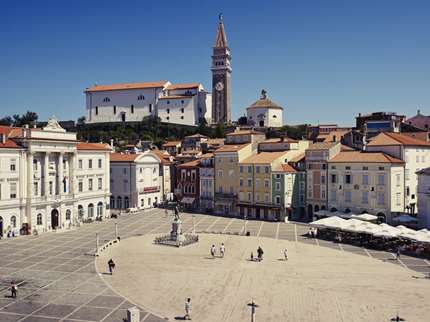Return
The Veneziana House
The Veneziana House is the best example of the Venetian-Gothic architecture in Piran. Its red facade is richly decorated by typically Gothic archaeological elements.
At the corner of IX Corpo Street and Tartini Square is the Veneziana House, a magnificent structure decorated in Venetian red and the best example of the preserved Venetian Gothic architecture in Piran. Erected in the mid 15th century by one of the most powerful families in Piran, the Del Bellos, it is considered the oldest structure on the square. Its facade is richly decorated by architectural elements and decorations or reliefs made in stone, typical for Venetian Gothic. The first floor of the main facade, the one facing Tartini Square, is adorned by the Gothic triple-lancet window with pointy window finishes, between which relief stone rosettas are places, and serrated decoration characteristic for the building method of the period. Apart from the triple-lancet window, the floor also has a magnificent corner balcony, with a stone balustrade. The balustrade was made of thin columns ending in basket shaped capitals, while the plate above it, in the corners and in the centre, is decorated by plastic made human heads. Another human head was placed at the corner of the building as a stone relief. The second floor of the Veneziana House faces the square with its two single-lancet windows, also richly decorated. Both have a ledge with the carved lion head supporting elements. The stone plate with a carved lion is placed between the single-lancet windows. The lion holds the inscription Lasa pur dir between its paws. The meaning of the inscription has been heavily debated. The legend speaks of the love between a young girl from Piran and a rich merchant from Venice. Evil tongues of Piran made the girl's life difficult while her beloved one was away on a far journey. Because of her constant complaints, the light-hearted merchant had the inscription made: Lasa pur dir – Let them speak.








